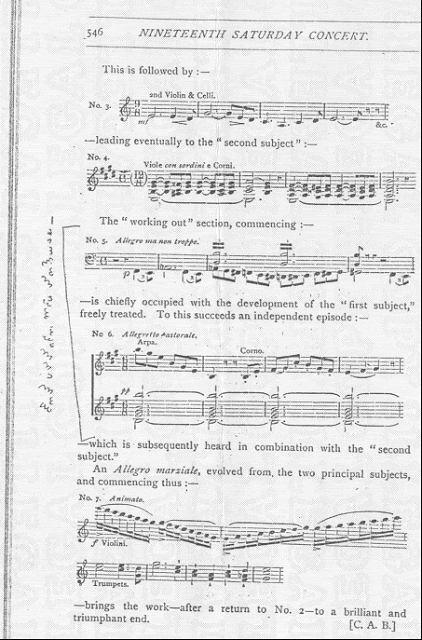As regular Cipher Mysteries readers will know, Edward Elgar’s most famous ciphertext is the Dorabella Cipher, a tiny cryptographic walnut that continues (more than a century after it was produced) to defy all cryptologic jackhammers sent to crack it.
A confusing part of the mystery is that in the 1920s, Elgar (re-)used the same pigpen-style “rotating-3” alphabet as a simple substitution cipher in two pages of his notebooks (the “MARCO ELGAR” / “A VERY OLD CYPHER” / “DO YOU GO TO LONDON TOMORROW?” page reproduced here. These messages are easily deciphered (helpfully, the key is reproduced on the page itself), so the two ciphertexts appear to have nothing to do with each other apart from their shared alphabet.
Furthermore, what I didn’t realise until last year (but never quite got round to mentioning here) is that Elgar re-used these same cipher shapes in two other places. Firstly, the “Liszt fragment” in the margin of an 1885/1886 Crystal Palace Saturday Concert Programme, which is basically a string of the same rotating-3 alphabet:
Tony Gaffney thinks that this is trivially solvable by using one of the “clock-face” diagrams from the 1920s notebook, but I think this mainly depends on whether you think the kind of language Tony believes the main Dorabella cipher was enciphering had the same kind of allusive & abbreviated private codewords as this (short) message.
But there is also one other place we know of in Elgar’s notes where these distinctive shapes appear, and it is in a decidedly cryptographic context. In 1896, the Pall Mall Magazine published an article with an “uncrackable” code challenge for readers, one based on the Russian Nihilist cipher. However, Elgar took such great delight in cracking it that he later had it painted on the floor: he also wrote his explanation on nine cards (“the Courage card set”).
What is odd is that ten of the rotating-3 alphabet letters appear on the first card of this set. The description given of these is of the set of eight rotating triple cup shapes, followed by an upward-facing double cup and finishing with an upward facing single cup. I haven’t seen an image of this in context, but Christian Schridde reconstructed one for one of his very readable “NumberWorld” blog posts on the Dorabella Cipher:-
In Christian’s third Dorabella post, he muses on the timeline aspects: that the Liszt fragment is more than a decade earlier than Dorabella, while the “MARCO ELGAR” page is more than two decades later. By contrast, the ink was only just dry on the Courage card set when the Dorabella cipher itself was written.
Schridde therefore wonders whether the Dorabella cipher might use some element of the Nihilist cipher (which, itself, is a kind of bodged-together mix of Polybius square and Vigenère cipher): certainly, this cipher must have been almost as fresh in Elgar’s mind as the paint on his wooden floor.
On the one hand, the fact that there are ten rotating-3 symbols on the card seems to vaguely imply that Elgar was trying to see a way of mapping a set of digits [0-9] onto his rotating-3 alphabet: which, given that the Nihilist cipher system enciphers individual plaintext letters as 2- or 3-digit numbers, does seem oddly coincidental.
And yet there is no obvious sign of digit pairing or grouping, which you’d perhaps expect if you were seeing something Polybius-style or perhaps groups of digits: the ABAB-style length pattern at the start of the Dorabella (2323121312…) quickly disappear, replaced by quite different structures (e.g. 22222 and 111111 on the second line).
At one point, I also wondered whether the sequence on the first Courage card might in fact be a kind of length-10 sequence to offset the Dorabella symbols, that I previously called a “rotating pigpen”, e.g.
+0/0, +1/0, +2/0, +3/0, +4/0, +5/0, +6/0, +7/0, 0/-1, 0/-2
Well, given that this is a reasonable possibility, I tried out a few variants of it in Excel… but nothing plausible-looking jumped out at me, which was basically what happened when I tried a similar rotating pigpen in C code hack before.
I really don’t know what’s going on with all Elgar’s cipher bits, particularly the Liszt fragment. Of his three undecrypted mini-ciphertexts, the Dorabella is in some ways the least odd – it at least looks like a proper cryptogram with proper-looking statistics, something to get your cryptologic teeth into. The mystery deepens! 🙂


Intriguing.
The ‘Courage card’ set is wildly referenced and appears to be held in Elgar’s birthplace museum (www.elgarmuseum.org) , I have not found a single transcription of the 9 cards anywhere on the web.
But even more, the order and look of the 10 symbols on top of the first card is currently still a best guess based on a description in an old article. It would be nice if someone in the neighborhood could pop in there and resolve at least that part of the mystery 🙂
Reminds me of a band-leader’s opening rhythm: a-one, a-two, and “waltz” rhythm: 1-2-3, 1-2-3, …….and the band played on….
🙂